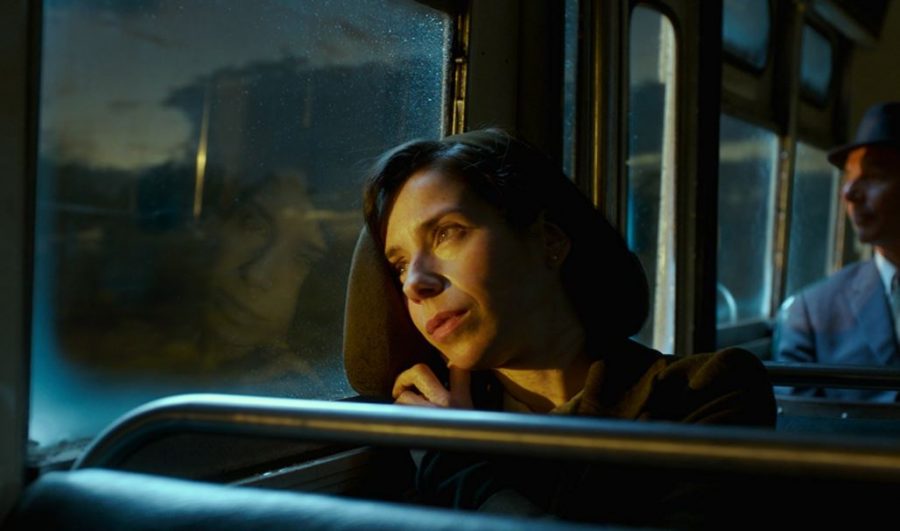The Shape of Water: Relating to an incomprehensible romance
Fox Searchlight Pictures- Twentieth Century Fox Film Corporation
Despite the marvelous acting and aesthetic of the film, Del Toro is not capable of crafting a relatable romance. This post contains spoilers regarding the plot of the film.
Guillermo Del Toro’s The Shape of Water not only won best picture at the 90th academy awards, but the film also won multiple Oscars for direction, music, and production design. In a cold war time period, the film features a trio of societally oppressed friends, the main protagonist being a mute girl named Elisa (portrayed by Sally Hawkins). The film attempts to highlight a message of a modern, limitless love, but fails in regards to the construction of a relatable romance between the fish man and Elisa.
Within the first few moments, the film’s beautiful musical compositions and enchanting visual aesthetic captures the interest of the audience. Narrated by Elisa’s neighbor and closeted companion Giles, the framework is set up by emphasizing Elisa’s desperate emotional state. She craves something more than the basic companionship that surrounds her. Continually, Elisa’s work life provides her limited comfort. Although she has the company of her talkative African American friend Zelda, Elisa constantly has to outsmart a boss who not only treats her as inferior, but also fetishizes her.
The day the asset enters the plot, Elisa is intrigued by the amphibian’s situation, which mirrors her own complications. Using sign language, music, and eggs, she is able to win over the trust of this foreign creature that now seems remotely human-like. As the asset is subject to torment and is ultimately sentenced to death, the audience empathizes with Elisa’s attempt to free the creature.
This is the primary point where the audience needed to see a challenge to Elisa’s growing affections towards the amphibian, and Zelda delivered a weak argument while wrestling over the transportation cart. Viola Davis’s acting was brilliant; however, because this was an escape scene, it was understandable that Zelda had limited time to prove that her loyalty was truly to Elisa. The audience anticipated future conflict between the peers to bring the film a sense of reality.
However, Guillermo del Toro fails to deliver this pivotal plot point yet again when the amphibian is now sheltered in Elisa’s abode. All of the director’s efforts to make the creature seem human in a romantic aspect vanished as the asset reverts to an animalistic nature.The amphibian is not only caught fleeing the scene as a natural response to a foreign environment, but is also shown to be reckless in nature, munching gorily on Giles’s cat. Del Toro fails to make this romance realistic in the aspect that the slaughter of the cat and animalistic flight tendencies are romanticized as opposed to being met with challenge. Giles casually dismisses the death of his cat, and Elisa simply finds the creature engaged in the cinema below her home.
The creature and Elisa ultimately pursue more intimate relations with one another, which was the final mistake in the film’s attempt to make the romance remotely understandable. Zelda and Giles only encourage this behavior by looking solely at the romantic aspect of the relationship. Giles, inspired by a complicated scene, even artistically depicts Elisa and the amphibian together. Phenomenal acting, beautiful musical direction, and stunning visual effects are the only things left keeping the audience engaged in the romance.
The one redeeming quality of the film was the ambiguous ending. Like water, the ending fills the shape of the viewer’s imagination. The story closes with the couple floating in the water, as Giles reads a poem to highlight the message of the film, regardless of the ultimate result.
He states, “If I told you about her, what would I say? That they lived happily ever after? I believe they did. That they were in love? That they remained in love? I’m sure that’s true. But when I think of her – of Elisa – the only thing that comes to mind is a poem, whispered by someone in love, hundreds of years ago: “Unable to perceive the shape of You, I find You all around me. Your presence fills my eyes with Your love, It humbles my heart, For You are everywhere.”
The simplistic poem is the last testament to the incomprehensible romance portrayed throughout the film. Although the audience may not be able to understand the relationship, they must respect the love shared between the two beings.
Perhaps it was Del Toro’s idea to eliminate challenges to convey the alienated state of the three characters; however, the audience needed to understand the relationship between the fish man and Elisa in order to truly be inspired by Del Toro’s message. Relationships are complicated, and overcoming hardship strengthens the bond between any two individuals. By inserting more shock and challenge from Elisa’s peers, Del Toro would have been able to craft a more romantic relationship that would be more relatable to the audience. Not only would this help the plot, but also it would further Del Toro’s concept of unconditional love.
Your donation will help support The Lambert Post, Lambert High Schools student-run newspaper! Your contribution will allow us to purchase equipment and cover website hosting costs.








